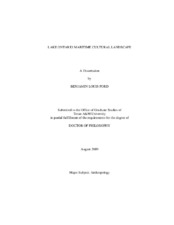| dc.description.abstract | The goal of the Lake Ontario Maritime Cultural Landscape project was to
investigate the nature and distribution of archaeological sites along the northeast
shoreline of Lake Ontario while examining the environmental, political, and cultural
factors that influenced the position of these sites. The primary method of investigation
was a combined archaeological and historical survey of the shoreline within seven 1-km
square areas. The archaeological component of the survey covered both the terrestrial
and submerged portions of the shore through marine remote sensing (side-scan sonar and
magnetometer), diving surveys, pedestrian surveys, and informant interviews.
A total of 39 sites and 51 isolated finds were identified or further analyzed as a
result of this project. These sites ranged from the Middle Archaic period (ca. 5500-2500
B.C.) through the 19th century and included habitation, military, transportation, and
recreational sites. Analysis of these findings was conducted at two scales: the individual
survey area and Lake Ontario as a whole. By treating each survey area as a distinct
landscape, it was possible to discuss how various cultures and groups used each space
and to identify instances of both dynamism and continuity in the landscapes. Results of
these analyses included the continuous occupation of several locations from pre-Contact
times to the present, varying uses of the same environment in response to political and
economic shifts, the formation of communities around transportation nodes, and
recurring settlement patterns. The survey data was also combined to explore regional-scale
trends that manifest themselves in the historical Lake Ontario littoral landscape including ephemeral landscapes, permeable boundaries, danger in the lake, and factors
of change. | en |


